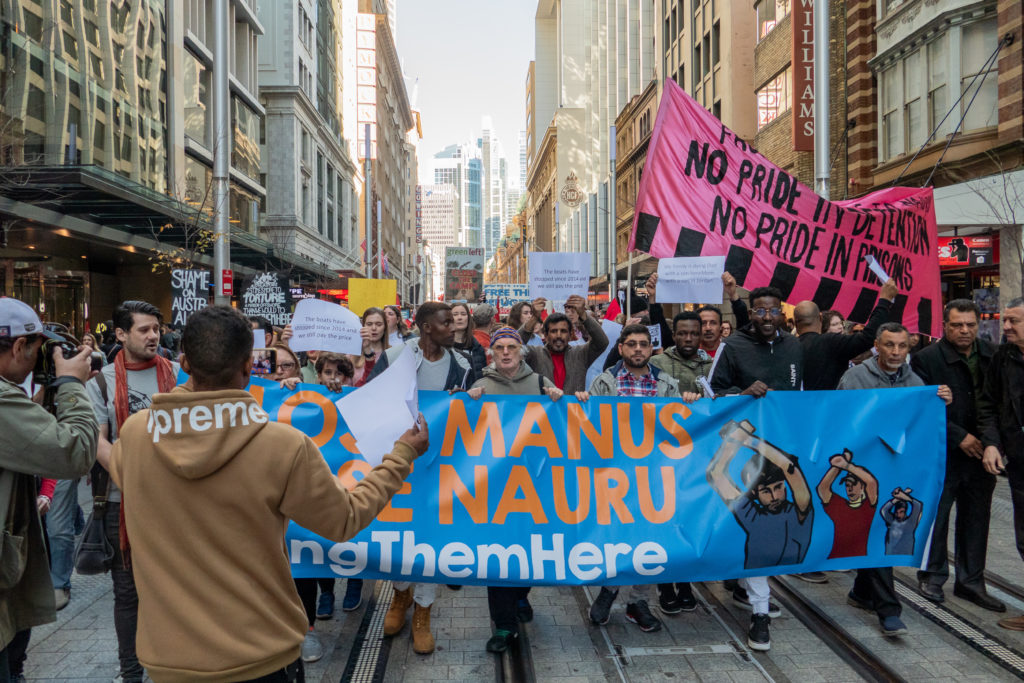MIGRATION DETENTION RIOTS AT MANUS ISLAND
Manus Island: Unpreparedness and Poor Training in the Face of Unrest
The Australian immigration detention centre on Manus Island in Papua New Guinea faced a series of riots which were violently repressed by security guards in February 2014 and in January 2015. During these riots, several injuries and deaths occurred, with private security personnel allegedly both participating in the violence against asylum seekers and others sustaining long-term emotional trauma from the riots. Sudden influx of arrivals, fearful responses by asylum seekers to the possibility of resettlement, and inadequate security training and infrastructure led to these incidents. The Australian government ultimately settled with the former security guards, and paid compensation to former detainees after Papua New Guinea found the centre to be illegal. Finally, two guards that were allegedly implicated in the death of an asylum seeker were convicted and sentenced to 10 years in jail by Papua New Guinea’s national court.
Keywords: migration, poor training, clash with locals
Background
Manus Island in Papua New Guinea was one of three offshore immigration detention centres used by Australia. Under Australia’s immigration policy, every immigrant arriving to Australia is to be detained and processed, with those found to be legitimate refugees allowed to resettle in Papua New Guinea or Cambodia.
Manus Island was originally opened to house asylum seekers who came to Australia by boat in 2001. Many asylum seekers started attempting the journey to Australia by sea, and more than 1,200 people drowned trying to get to Australia. In order to limit the amount of people arriving by boat to seek asylum, the policy was changed so that any asylum seeker arriving by boat would have no chance of being allowed to settle in Australia.
Since the opening of Manus Island, the centre has been criticised for high rates of depression and anxiety among detainees, under-sourced facilities and poor living conditions, and a lack of access for human rights organisations.
In an Australian Parliament, a senate committee recognized several factors that gave rise to the February 2014 riots, including the size and composition of the Manus Island centre; tension between asylum seekers and locals; the condition of the facilities at the centre; inadequate security infrastructure at the centre; and uncertainty about refugee status and resettlement arrangements.
Prior to the 2015 riots, it was reported that refugees believed their lives were endangered due to the Australian government’s plans to move detainees to Lorengau, the capital of Manus province. Refugees allegedly believed they would be attacked by local people if they moved to the capital; some refugees were so frightened that they refused to leave the centre.
The Incident
In February 2014, unrest at Manus Island resulted in 77 injuries, one by a gunshot, and one death from a head injury. There had been escalating protests at the centre for a few days, with the protestors breaking through fences a few days into the protest. Allegedly, on the first day of the demonstrations, refugees were hopeful that immigration authorities would tell them how much longer they would have to stay at Manus Islands. When they did not receive an answer to this question, a riot started the same night.
Immigration Minister Scott Morrison claimed that asylum seekers initially caused the disturbance and broke out of the centre, but refugee advocates and people inside the facility claimed that police and locals entered the compounds with weapons and attacked detainees. This caused asylum seekers to flee outside of the compound.
In January 2015, over 100 asylum seekers went on a hunger strike, protesting their treatment at the detention centre. A few days later, more asylum seekers joined the protest, while running water allegedly became unavailable at Manus Island. Local security guards went on strike after going unpaid.
After a few days, strikers started to collapse without food or water, with other strikers starting to consume harmful materials in protest. Around this time, riot police entered the detention centre. International Health and Medical Services (IHMS) staff converted the staff cafeteria into an emergency medical centre, treating over a hundred detainees.
The next day, multiple strikers were allegedly taken to the “Chauka” solitary confinement unit. In response, an urgent petition to the UN special rapporteurs on human rights was lodged overnight by refugee advocates. The same day, it was reported that security personnel started to round people up, attempting to end the protest. The next day, guards in riot gear allegedly entered Manus Island compounds, attempting to end the protest by force, taking alleged riot “ringleaders” into the Chauka isolation unit.
Legal Aspects
Court cases
After the riots, former G4S guards filed a lawsuit against the company and the government, alleging that the two parties were responsible for the failures related to the riots. Specifically, the former guards claimed that G4S and the government inadequately trained staff, and did not make personal protective equipment available to them. This, the guards alleged, resulted in their physical and mental harm.
Australia has a duty of care to asylum seekers under Australian law, and may be vicariously liable for any breach of this duty.
In support of the former guards´ claims, emails were shown to the court that showed G4S´ requests for additional 100 security guards at the site, warning there was increasing awareness of the possibility of conflict.
In July 2021, the parents of asylum seeker Reza Barati sued the Australian government over his death during the February 2014 detention centre riots. It was alleged that Mr. Barati was beaten to death by guards and other workers. Specifically, court documents stated that Mr. Barati was returning to his room after gunshots were fired into his compound, when a Manus Island worker in a G4S uniform hit him from behind with a length of timber spiked with nails. Then, up to 10 men kicked him in the head.
Mr. Barati’s parents claimed that the Australian government’s negligence, in addition to G4S negligence, were to blame for Mr. Barati’s death. The Barati family alleged that tensions had increased in the six months leading up to the violent riots, and the number of detainees increased tenfold, with over 500 more detainees living at the centre than the amount the centre was built to house. Thus, Mr. Barati´s parents alleged that the government and G4S should have had notice of the likelihood of violent protests occuring, and that the parties should have ensured staff were properly trained and that the centre was equipped to deal with outbreaks of violence.
Earlier, two men were convicted for Mr. Barati’s death and sentenced for 10 years in jail by Papua New Guinea’s national court.
The International Code of Conduct
The International Code of Conduct requires that Personnel of Member and Affiliate companies take all reasonable steps to avoid the use of force, and if force is used, it should be proportionate to the threat and appropriate to the situation. (Rules on the Use of Force : paragraph 29, Use of Force : paragraph 30-32).
Additionally, security personnel are only allowed to apprehend persons to defend themselves or others against an imminent threat of violence following an attack or crime against Company Personnel, clients, or property under their protection. Apprehension and detention must be consistent with international and national law, and all apprehended and detained persons must be treated humanely and consistent with their status and protections under applicable human rights law and international humanitarian law. (Detention: paragraph 33)
Resources on Apprehending Persons
The Code states that Member and Affiliate Companies will only, and require their personnel to treat all detained persons humanely and consistent with their status and protections under applicable human rights law and international humanitarian law, including prohibitions on cruel, inhuman, or degrading treatment or punishment (paragraph 33).
The Code requires stringent selection and vetting of personnel, assessment of performance and duties (paragraphs 45 to 49), and training of personnel of the Code and relevant international law, including human rights and international criminal law (paragraph 55). Meeting the requirements of the Code of Conduct, can help private security companies and their clients ensure that private security personnel are qualified, trained, supported, informed, and responsible.
Meeting the requirements of the Code of Conduct can help private security companies and their clients ensure that private security personnel are qualified, trained, supported, informed, and responsible.
Impact
Investigations
In an Australian Parliament report, a Senate Committee stated that the factors giving rise to the February 2014 incident should have been known to Australia and the contracts managing the centre. The committee concluded that the Australian government therefore failed in its duty to protect asylum seekers from harm.
The Report found that many G4S staff continued to defend asylum seekers at great risk to their own safety during the riots, however, the Report recognized that many G4S staff and local residents used excessive force with the asylum seekers, or were involved in violence against the asylum seekers.
The Report concluded that asylum seekers suffered numerous violations of basic human rights during the February 2014 riots, including the right to life and the right to security of person.
Settlements and Fines
By September 2022, fifteen former employees of G4S reached a confidential settlement totalling millions of dollars with G4S and the Australian Government.
In October 2021, Australia ended offshore immigration processing on Papua New Guinea. The Manus Island centre was found to be illegal and ordered shut by the Papua New Guinea Supreme Court in 2016, and Australia was forced to pay $70m in compensation to those unlawfully detained. Those still detained in Papua New Guinea were allowed to transfer to the Nauru processing centre, otherwise they were offered a “permanent migration pathway … including access to citizenship, long-term support, settlement packages and family reunification”.
Discussion
The Australian parliament, in a report, determined that the factors giving rise to the incidents should have been known to the Manus Island managing personnel. How can private security companies and their personnel be aware of and address risks of violence and conflict?
What are the specific responsibilities of private security personnel when engaging in dealing with people in vulnerable situations such as detained migrants?
Related incidents
- Escobal Mine: Violent Repression of Indigenous Protests
- Violent Repelling of Illegal Miners Leading to Litigation
- The Nisour Square Massacre
- Repression of the Protests Against the Rio Blanco Mine
- Racist Murder by Supermarket Guards
- Violence and Sexual Assaults at Kakuzi Farms
Sources
- Australia asylum: Protests continue at Manus Island camp – BBC News
- Incident at Manus Island Report – Chapter 8 – Parliament of Australia
- Manus Island has shut – but hundreds of asylum seekers say they’re now stranded
- Manus Island: a troubled history | Australian immigration and asylum | The Guardian
- Manus Island detention centre protests: timeline
- Reza Barati’s parents sue Australia over son’s murder on Manus
- Manus Island: One dead, 77 injured and person shot in buttock at Australian asylum centre | Australia news | The Guardian
- Four years after Reza Barati’s death, we still have no justice | Behrouz Boochani | The Guardian
- Government and security company reach multimillion-dollar settlements with Manus Island guards | Australia news | The Guardian
- Commonwealth government failures led to deadly riot at Manus Island, court hears | SBS News
- Australia to end offshore processing in Papua New Guinea | Australian immigration and asylum | The Guardian
Case prepared by Madison Zeeman
Clause de non-responsabilité
Conformément à l’avis de non-responsabilité figurant sur la page d’accueil, ni l’Association Internationale du Code de Conduite ni les auteurs ne peuvent être identifiés avec les opinions exprimées dans le texte ou les sources incluses dans « Plaider en Faveur d’une Sécurité Responsable : Carte de Cas du Code de Conduite International ».

